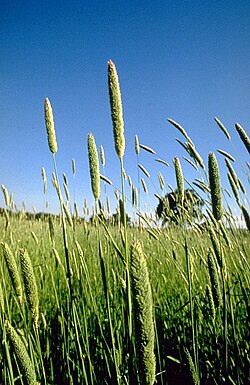Alkaloids
Some Phalaris species contain gramine, which, in sheep and to a lesser extent in cattle, is toxic and can cause brain damage, other organ damage, central nervous system damage, and death. [1] [2]
Phalaris arundinacea , Phalaris aquatica , and Phalaris brachystachys are known to contain the alkaloids DMT, 5-MeO-DMT, and 5-OH-DMT (bufotenin). Some research has been done into the variability of alkaloids in the Phalaris grasses. Strains with high levels of alkaloids are best avoided in locations with grazing cattle and sheep, due to potential toxicity. Such high-alkaloid strains include Phalaris aquatica AQ-1 and the species P. brachystachys. Seasonal and weather patterns also appear to affect alkaloid concentration, as most toxicity occurs in autumn and in times of drought. Regrowth after grazing or mowing also shows a considerable increase in alkaloids.
In June 2018, mobs of wild kangaroos were observed [3] suffering from "phalaris staggers" which causes head tremors, a loss of co-ordination and collapse. When phalaris is used to feed livestock, farmers can administer cobalt to their animals or spray it on their pastures to protect animals against the effects of phalaris. However, this treatment is not available to wild kangaroos and they suffer from poisoning due to the alkaloids. The staggers syndrome is more common in livestock in areas with limestone soils, which contain less cobalt than basalt soils.
None of the above alkaloids is said to have been found in P. californica, P. canariensis, P. minor and hybrids of P. arundinacea together with P. aquatica. [4]
This page is based on this
Wikipedia article Text is available under the
CC BY-SA 4.0 license; additional terms may apply.
Images, videos and audio are available under their respective licenses.
